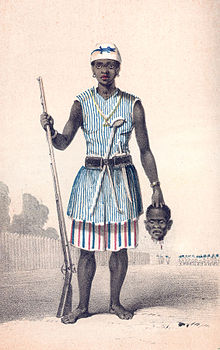- Dahomey Amazons
-
The Dahomey Amazons or Mino were a Fon all-female military regiment of the Kingdom of Dahomey (now Benin) which lasted until the end of the 19th century. They were so named by Western observers and historians due to their similarity to the semi-mythical Amazons of ancient Anatolia and the Black Sea.
Contents
Origin
 Dahomey Amazons in around 1890
Dahomey Amazons in around 1890King Houegbadja (who ruled from 1645 to 1685), the third King of Dahomey, is said to have originally started the group which would become the Amazons as a corps of elephant hunters called the gbeto.[1] During the 18th century, the king had some of his wives trained as royal bodyguards.
Houegbadja's son King Agadja (ruling from 1708 to 1732) developed the female bodyguard into a militia and successfully used them in Dahomey's defeat of the neighbouring kingdom of Savi in 1727. European merchants recorded their presence, as well as similar female warriors amongst the Ashanti. For the next hundred years or so, they gained reputation as fearless warriors. Though they fought rarely, they usually acquitted themselves well in battle.
The group of female warriors was referred to as Mino, meaning "Our Mothers" in the Fon language by the male army of Dahomey.[2] From the time of King Ghezo (ruling from 1818 to 1858), Dahomey became increasingly militaristic. Ghezo placed great importance on the army and increased its budget and formalized its structures. The Mino were rigorously trained, given uniforms, and equipped with Danish guns (obtained via the slave trade). By this time the Mino consisted of between 4000 and 6000 women, about a third of the entire Dahomey army.
Recruitment
The Mino were recruited from among the ahosi ("king's wives") of which there were often hundreds.[3] Some women in Fon society became ahosi voluntarily, while others were involuntarily enrolled if their husbands or fathers complained to the King about their behaviour. Membership among the Mino was supposed to hone any aggressive character traits for the purpose of war. During their membership they were not allowed to have children or be part of married life. Many of them were virgins. The regiment had a semi-sacred status, which was intertwined with the Fon belief in Vodun.
The Mino trained with intense physical exercise. Discipline was emphasised. In the latter period, they were armed with Winchester rifles, clubs and knives. Units were under female command. Captives who fell into the hands of the Amazons were often decapitated.
Conflict with France
European encroachment into west Africa gained pace during the latter half of the 19th century, and in 1890 King Behanzin started fighting French forces in the course of the First Franco-Dahomean War. According to Holmes, many of the French soldiers fighting in Dahomey hesitated before shooting or bayoneting the Mino. The resulting delay led to many of the French casualties.
However, according to at least two easily-identifiable sources, the French army lost several battles to them—not because of French "hesitation," but due to the female warriors' skill in battle that was "the equal of every contemporary body of male elite soldiers from among the colonial powers" [4]
Ultimately, bolstered by the Foreign Legion, and armed with superior weaponry, including machine guns, as well as cavalry and Marine infantry, the French inflicted casualties that were ten times worse on the Dahomey side. After several battles, the French prevailed. The Legionnaires later wrote about the "incredible courage and audacity" of the Amazons. The last surviving Amazon of Dahomey died in 1979.
In popular culture
Dahomey Amazons were represented in the 1987 film Cobra Verde by German director Werner Herzog. Ghezo's Amazons play a significant role in the novel Flash for Freedom! by George MacDonald Fraser.
The unit is also depicted in (a special edition of, and now DLC of) PC game Empire: Total War.
A segment of QI Series 7 Episode 7 discussed Dahomey Amazons and showed a photo.
See also
References
- ^ Alpern, Stanley B. (1999). Amazons of Black Sparta: The Women Warriors of Dahomey. New York: New York University Press. p. 20. ISBN 0-81470-678-9.
- ^ Alpern, Stanley B. (1999). Amazons of Black Sparta: The Women Warriors of Dahomey. New York: New York University Press. p. 44. ISBN 0-81470-678-9.
- ^ Alpern, Stanley B. (1999). Amazons of Black Sparta: The Women Warriors of Dahomey. New York: New York University Press. p. 38. ISBN 0-81470-678-9.
- ^ Alpern, Stanley B. (1999). Amazons of Black Sparta: The Women Warriors of Dahomey. New York: New York University Press. ISBN 0-81470-678-9.
Bibliography
- Women Warlords: An Illustrated Military History of Female Warriors Tim Newark and Angus McBride, Blandford Press
- Acts of War: the behavior of men in battle Holmes R. New York, Free Press, 1985. Quoted in:
- On Killing: The Psychological Cost of Learning To Kill in War and Society Grossman D. New York, Back Bay Books / Little, Brown and Company, 1995 ISBN 0-316-33011-6 pp. 175
- Der Atlantische Sklavenhandel von Dahomey, W. PEUKERT, 1740–1797, Wiesbaden, 1978
External links
Categories:- All-female military units and formations
- African women in war
- Military history of Africa
- Dahomey
- French West Africa
Wikimedia Foundation. 2010.

